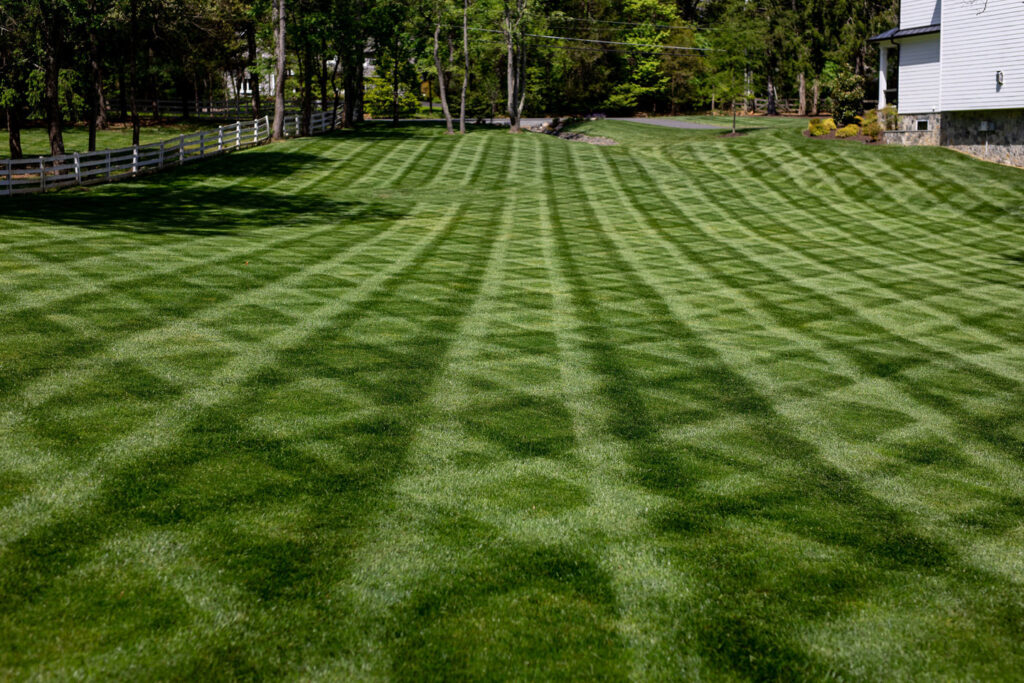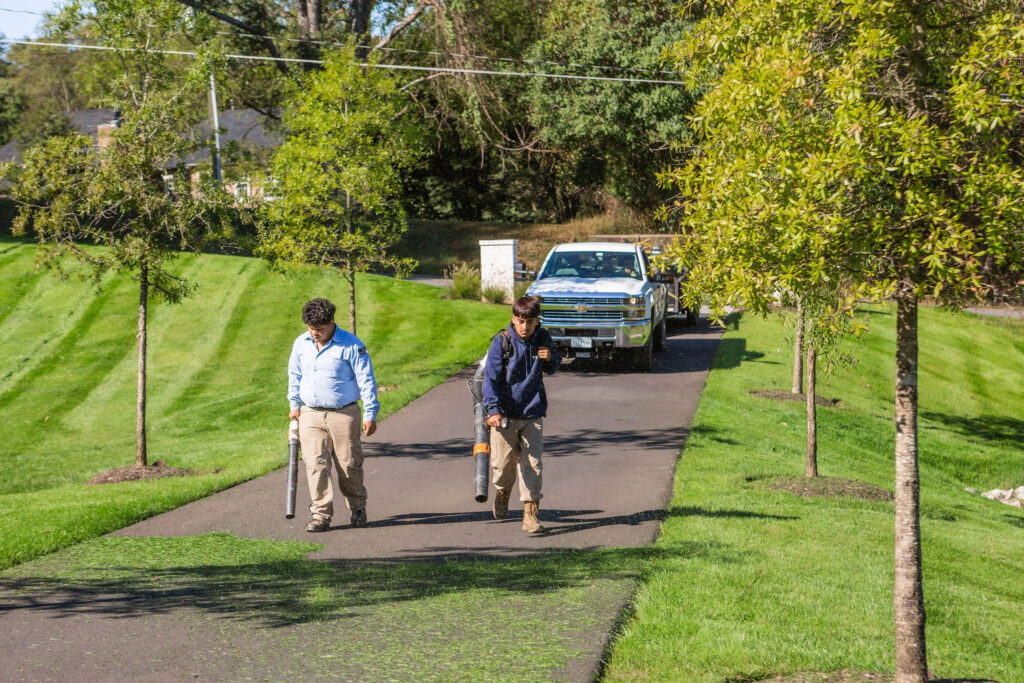Summary
When it comes to lawn maintenance for fall, mowing later helps your lawn stay healthy through the colder months, supports new growth from aeration and overseeding, and keeps your yard tidy as leaves turn. When paired with consistent leaf removal and a professional lawn mowing service, this practice ensures your grass survives winter and comes back lush, green, and vibrant in spring.
Table of Contents
Introduction
When temperatures drop and growth slows, it’s easy to assume your lawn doesn’t need much attention. Many homeowners put the mower away after the first chilly weekend, planning to revisit the yard in spring. But here’s the truth: lawn maintenance for fall is one of the most important investments you can make in your property’s long-term health.
At Independence Landscape, we’ve seen time and time again how late-season mowing sets the stage for beautiful spring lawns across Northern Virginia. Continuing to mow later into the fall (if weather dictates – sometimes well into November or even December) helps your grass build resilience, resist disease, and maintain that clean, well-kept look all season long.
Your lawn doesn’t stop working just because summer ends. Beneath the surface, roots are still growing and strengthening, preparing for winter dormancy. Late-season mowing helps support that process, ensuring your lawn goes into the cold months strong and wakes up in spring ready to thrive.
Why Late-Season Mowing Makes a Big Difference
1. Stronger, Healthier Roots Before Winter
As cooler weather sets in, your lawn transitions from active top growth to underground root development. Mowing later in the season supports this process by allowing sunlight and oxygen to reach the base of each grass plant. Shorter blades mean more efficient photosynthesis and stronger roots, which are key factors in how your lawn survives the winter.
This step is especially important for cool-season grasses common in Northern Virginia, like fescue. These varieties continue to grow slowly in the fall, even as temperatures dip into the 40s. Regular mowing during this period helps maintain an ideal height (around 3.5 inches) that promotes healthy root systems and reduces stress before dormancy.
Expert Tip: According to turf specialists at Virginia Tech University, maintaining consistent mowing height through late fall helps grass retain carbohydrates, which serve as stored energy during the winter months.
2. Better Sunlight and Airflow for New Grass
If your lawn has been aerated and overseeded (a common fall treatment) new seedlings need light and space to establish strong roots. Overgrown grass can shade out those tender shoots, preventing them from getting the sunlight they need to mature before frost.
Continuing to mow later into the season ensures these new seedlings thrive. Our Independence Landscape crews carefully adjust mowing height to avoid damaging young grass while still promoting even coverage. The result? A denser, more uniform lawn that greens up quickly in spring.
Late-season mowing also improves airflow at the soil surface, which helps prevent moisture buildup and fungal problems. By reducing thatch and debris, your grass stays dry and healthy even as fall rains increase.
3. Natural Leaf Management and Debris Control
Fall in Northern Virginia means colorful trees and a steady blanket of leaves. Left unchecked, that blanket can quickly smother your lawn. Thick layers of leaves block sunlight, trap moisture, and can even promote the growth of snow mold and other lawn diseases.
Our mowing crews help manage this naturally. During weekly visits, we use blowers to move leaves off your lawn and into designated landscape beds or collection areas. This keeps the turf surface clear while complementing our dedicated leaf removal services. It’s an efficient system that keeps your property looking clean and prevents your grass from suffocating under organic debris.
Mowing through late fall helps manage leaf buildup while reducing the workload of full-scale cleanups.
4. Preventing Mold, Matting, and Snow Damage
One of the most overlooked benefits of mowing later is preventing matting and snow compaction. When grass is left too tall before the first snowfall, blades bend under the weight of snow, creating damp, shaded pockets where snow mold can form. This fungal disease appears as gray or pink patches in spring and can damage your lawn for months.
By giving your lawn a final cut before winter (at a slightly shorter height) you minimize that risk. The grass stands upright, air circulates more freely, and moisture evaporates quickly. That small adjustment helps your lawn avoid disease and recover faster when the weather warms.
How a Professional Lawn Mowing Service Enhances Results
While it’s possible to mow your lawn yourself in late fall, partnering with a professional lawn mowing service ensures the job is done safely, efficiently, and with an expert eye for detail. At Independence Landscape, we’ve refined our mowing and lawn maintenance for fall, so that the process aligns with the unique needs of Northern Virginia properties.
Here’s what sets our approach apart:
- Consistent Weekly Visits: Our crews continue mowing as long as weather dictates, often through late November or early December.
- Proper Mowing Heights: We adjust blade height carefully throughout the season to encourage strong root systems and reduce stress on the grass.
- Comprehensive Cleanup: Every visit includes edging, debris removal, and blowing off walkways, patios, and driveways.
- Integrated Care: Our mowing schedule is coordinated with fertilization, aeration, and leaf removal visits for seamless seasonal care.
Working with professionals means you don’t have to guess when the last cut should be, or risk damaging your lawn by mowing too short. Our team monitors growth patterns and weather trends to make the best timing decisions for your property.


The Overlooked Connection Between Mowing and Lawn Health
Mowing is a cornerstone of plant health. Each time you mow, you’re effectively pruning the grass, which stimulates growth and strengthens the plant’s internal systems. But mowing too infrequently in the fall can have the opposite effect.
Here’s why consistency matters:
- Nutrient Efficiency: Shorter grass blades allow better nutrient distribution from the soil to the leaves.
- Disease Prevention: Regular mowing limits moisture buildup and reduces thatch, creating a less hospitable environment for mold and pests.
- Improved Aesthetics: Even in the late months, maintaining neat edges and clean lines gives your property a polished, cared-for appearance that lasts through the holidays.
A properly mowed fall lawn doesn’t just look good, it functions better too.
Pairing Mowing with Seasonal Leaf Removal
Mowing and leaf removal go hand-in-hand in the fall. While mowing handles light debris, large accumulations require dedicated removal. Independence Landscape’s Three-Time Leaf Removal service keeps your property clean throughout the season with scheduled visits in November, December, and January.
This approach prevents leaves from matting your lawn and ensures air and sunlight reach the soil surface. It also saves homeowners from dealing with heavy, wet leaf piles after winter storms. Combining both services, mowing and structured leaf removal, creates the best conditions for long-term turf health.
Did You Know? Leaves that are left to decompose can alter soil pH, increasing acidity and weakening grass over time. Regular removal or mowing helps maintain balance and promotes even nutrient distribution.
Integrating Late-Season Mowing Into a Complete Fall Plan
At Independence Landscape, we treat mowing as one part of a comprehensive, year-round program designed for the region’s specific growing conditions. Late-season mowing pairs naturally with other essential fall services:
- Aeration and Overseeding: Promotes root growth and fills in bare spots for a thicker spring lawn.
- Fertilization: Provides nutrients that strengthen grass before winter dormancy.
- Weed Control: Reduces cool-weather weeds that compete for nutrients and light.
- Leaf Removal: Keeps grass surfaces clear and prevents suffocation.
These combined efforts ensure your lawn not only survives but thrives through winter.
Conclusion
When it comes to lawn maintenance for fall, mowing later in the season might seem like a small detail, but it makes a big difference. This practice keeps your grass strong, prevents disease, manages leaves naturally, and maintains your property’s polished look through the holidays.
Pairing regular mowing with structured leaf removal and professional oversight ensures your lawn remains healthy and ready to flourish once spring arrives.
If you’re enrolled in our Lawn Care Program or weekly mowing service, reach out to your Account Manager to add Three-Time Leaf Removal to your schedule today.
FAQs About Lawn Maintenance for Fall
When should I stop mowing my lawn in the fall?
Continue mowing until your grass noticeably stops growing, which in Northern Virginia is often well into November. Some years, our crews mow into early December, depending on weather and soil temperatures.
How short should I mow before winter?
Aim for about 3.5 inches. This height protects roots while preventing matting or mold under snow. Cutting too short can stress the grass, while leaving it too tall can trap moisture.
Does it matter if I mow or remove leaves first?
Yes, the order and handling matter. When the leaves are light and dry, mowing over them (i.e. mulching) is a common strategy; you can treat fallen leaves as “free fertilizer” by running over them with the mower to shred them into fine particles. However, heavy or wet leaf accumulations should be removed or bagged to prevent smothering the grass, blocking sunlight, or creating fungal risks.
In what order should I mow, seed, and fertilize in fall?
That’s a smart question. The recommended sequence is:
- Mow first (to clear the lawn surface)
- Then aerate/overseed or repair bare spots
- Finally, apply fertilizer (especially fall formulations)
This order ensures seeds make good soil contact and nutrients go deeper, rather than being blocked by tall grass or debris.
Can I leave grass clippings on the lawn during fall mowing?
Yes. Leaving fine clippings is often recommended because they decompose and return nutrients to the soil, provided they’re not in thick clumps. Just avoid large clumps that block light or smother the grass.
What height should warm-season grasses be mowed in fall?
If your lawn includes warm-season grasses (less common in Northern Virginia), lift your mower deck slightly in late fall to help leaves absorb more sunlight before dormancy. Some guides suggest raising the height by about ½ inch.
Read More